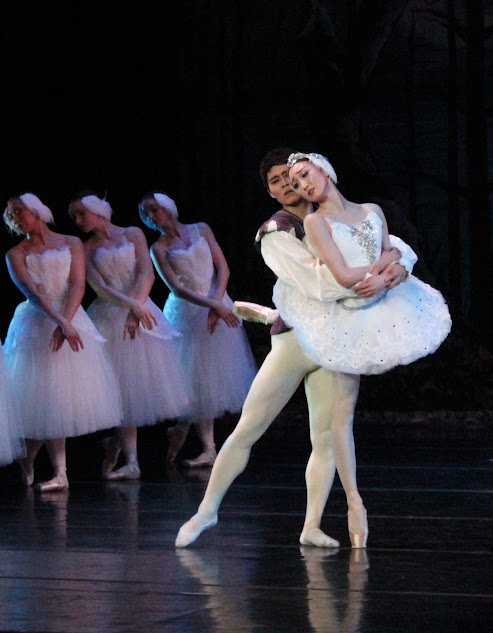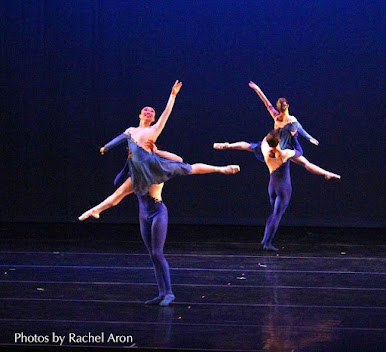Swept Up in the Moment - What is a Pas de Deux?
 |
| Photo by Rachel Aron |
‘Tis spring, and love is in the air. Love has certainly visited the stage, as Fort Wayne Ballet donned its Elizabethan finery recently to perform Prokofiev’s masterpiece, Romeo & Juliet. This greatest of love tragedies marked our last main stage show for what has been our 67th season, and it was a fine example of the dedication and athletic and artistic excellence to which our dancers strive to achieve.
Good day, readers. It’s good to be with you again.
If you’ve listened to our recent podcasts, you might have been as surprised as I was to learn that Romeo & Juliet is considered a modern ballet. It comes to us from the early 20th century, as opposed to tragic ballets of the romantic or classical periods, such as Giselle (circa 1841) or Swan Lake (circa 1877).
Don’t let the doublets fool you; this take on the star-crossed lovers has a modern sensibility in a multi-faceted performance. The roles in this masterwork require much more than a poignant arabesque or two; our dancers were asked to prove their skills in acting as well as stage combat, as several of the dancers have prolonged fencing scenes. These brilliant action sequences were pulled off with skill and aplomb by the company dancers to an appreciative audience, and I couldn’t help but admire some of those dancers who were able to perform that choreographed swordplay, not just with distinction of technique, but with a skillful comedic performance – a playful battle that transitioned into tragic death.
But for today’s blog, I would like to cycle back from tragedy and action sequences and delve into the spirit of the love story genre. I wanted to look at something representative of most ballets and absolutely essential to any great story ballet like Romeo & Juliet - that moment when two principal dancers come together to create their own world within the story. Two characters, who’ve spent the previous succession of scenes developing themselves to the audience as individuals, now connect, intertwine, and evolve into something complex and intrinsically romantic. Here is the pas de deux [PAA] + [DUH] + [DUR]: The French phrase literally meaning “step of two.”
If you’ve seen ballet, you’ve almost certainly experienced a pas de deux. Although ballet is full of powerful solos and intricate ensemble scenes, it’s always the duet that sticks in the mind. Some of ballet’s most memorable moments are coupled dances from the heavy hitters. Swan Lake features two very different Grand Pas’ – that of the White Swan and the Black Swan. The two dances feature same couple, but one utilizes an impostor character, with an entirely different energy and confidence level from that of the true Odette. The famous Dance of the Sugar Plum Fairy from The Nutcracker is the female variation from that ballet’s Grand Pas de Deux.
Ballet education time. So, what is this Grand Pas de Deux? Well, any ballet duet could be called a pas de deux, but it was the renowned choreographer Marius Petipa (Swan Lake, Coppélia, The Sleeping Beauty, The Nutcracker, Giselle, La Fille Mal Gardée, etc.) who formalized its structure. The official construction of the grand pas de deux is in five parts: the entrée, the adagio, two variations, and a coda. I’ll quickly break that down for you.
The Parts of the Grand Pas de Deux
First, the Entrée. This is the introduction to the duet and is often lively and showy. The entrée establishes the couple and brings them together into the adagio.
The Adagio. Adagio means “slowly.” This is the tender interaction, the emotional moment between the dancers. The adagio is a showcase for the ballerina, to feature her line and beauty.
Male Variation. This would be the male solo. It’s typically an opportunity for the male lead to showcase his athletic prowess and agility.
Female Variation. Depending on the emotion behind the dance, this solo can be one of joy and dexterity or grace and poignance. This is often the most iconic moment for the ballerina.
The Coda. Here, the dancers come together and wrap up the piece. Sometimes it is reflective of the previous sections, but it is grander, with the showboating typical of a finale.
There are many videos on YouTube of each of these components, and if you click on the links for my source material at the bottom, you’ll find some excellent examples as well. As I said, the grand pas de deux is very typical of the big, pre-modern romantic ballets that everyone knows, and therefore it’s the grand pas that most people probably think of in a couple’s dance.
Modern pas de deux are not as structured. They seem to be designed as a free flowing of emotion through dance. To me, always a layman, Romeo and Juliet appeared to dance like this. As the dance progressed, the feelings flowed naturally with the movements, with the partnership building like two young people discovering who they are to each other. It is an emotionally satisfying way to structure a performance. The modern aesthetic presents itself here, too, when the performers end the duet with an actual kiss, where a classical ballet would demand no more than a caress. The kiss made the scene that much more romantic and ultimately relatable.
The music adds to the emotional range of a duet as well, and Prokofiev’s score is beautiful – one of the best I’ve heard, and I do know a bit more about music than I do about dance. The Romeo & Juliet score is intimately cinematic, with beautiful cues and moments for the dancer to interact with the music. We’ve all experienced that moment where we have a favorite movie playing in the background at home, and you can tell what scene is playing from the next room because of the musical cues. Prokofiev wrote his ballets like this, with the scoring directly reflective of the scene in play. Kenneth MacMillan, the choreographer, didn’t waste a cue, with each motion in sync to a musical shadow.
If we move from the story ballet to take a look at the repertoire ballet, we see many short pieces that are entirely duets. Here we see ballets that are more concepts than stories. You might see a young man performing with the memory of his lost love or dancing with a supernatural being that symbolizes a character’s fate or destiny. For our Valentine’s show, Fort Wayne Ballet recently performed a comical piece in which a couple was trying, with increasing exasperation, to get dressed and ready for a night on the town. While many pas de deux focus on the romantic, it’s good to note that it can be used just as effectively to demonstrate that familiar relationship humor of everyday life.
I think that about takes care of our look at the “dance of two.” We are wrapping up our season at Fort Wayne Ballet, but we have a few fun things planned before summer break. On May 10th and 11th, we have our Studio Series show, Pints en Pointe, where we pair our repertoire pieces with select beers for you to sample. Mid-May will see our annual Firefly tour, which is a series of free, outdoor performances, open to the public, at several locations throughout Northern Indiana. You can find more details on these events at fortwayneballet.org.
See you again soon.
 |
| Photo by Rachel Aron |
Reference material:
Ballet Arizona, Ballet 101: Pas de Deux Breakdown
Kennedy Center, Pas de Deux: It Takes Two



Comments
Post a Comment